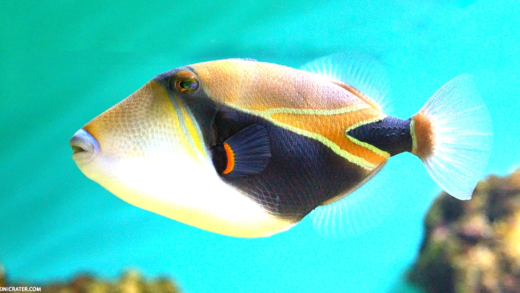Sea snakes thrive in warm coastal waters, particularly in the Indo-Pacific region, where they inhabit coral reefs, estuaries, and open ocean environments. Their unique movement capabilities stem from their streamlined bodies and paddle-like tails, allowing them to swim efficiently. If encountered while swimming, it’s important to stay calm, observe from a distance, and familiarize oneself with local species to ensure safety.
Sea Snakes vs Land Snakes
Sea snakes are fascinating creatures that differ significantly from their land counterparts. One of the most noticeable differences is their appearance. Sea snakes typically have a flattened body and a paddle-like tail, which helps them navigate effortlessly through water. In contrast, land snakes possess cylindrical bodies adapted for movement on solid ground.
Behaviorally, sea snakes are more aquatic. They spend most of their lives in the ocean, whereas land snakes are often found in various terrestrial habitats. Sea snakes breathe air but can hold their breath for extended periods while hunting or evading predators. This adaptation allows them to thrive in marine environments.
Understanding these fundamental differences is crucial for recognizing the unique adaptations of sea snakes. Their specialized features not only facilitate their survival in aquatic habitats but also set them apart from land snakes, making them a subject of interest for researchers and enthusiasts alike.
Species of Sea Snakes
There are over 60 species of sea snakes, each with unique traits and adaptations. Some notable species include:
- Olive Sea Snake (Aipysurus laevis): Known for its slender body and olive-green coloration, this species is prevalent in the Indo-Pacific region.
- Yellow-bellied Sea Snake (Pelamis platura): Easily recognized by its bright yellow belly, this snake is found in tropical waters and is known for its long migrations.
- Black Sea Snake (Hydrophis melanocephalus): This species features a distinct black head and is known for its potent venom.
Learning about these diverse species helps to appreciate the adaptability and ecological significance of sea snakes. Each species plays a vital role in its habitat, contributing to the marine ecosystem’s balance.
Venomous vs Non-Venomous Sea Snakes
When discussing sea snakes, a critical aspect is understanding which species are venomous and which are not. Some sea snakes, like the Black Sea Snake, possess venom that is far more potent than that of many land snakes, including rattlesnakes. This venom is used for subduing prey and can be dangerous to humans.
On the other hand, there are also non-venomous species, such as the non-venomous Sea Krait (Laticauda spp.), which primarily relies on their physical attributes for protection. Recognizing the danger levels of various sea snake species is essential for safety, especially for those who enjoy swimming or diving in their habitats.
Understanding these distinctions not only highlights the complexity of sea snake biology but also enhances awareness for marine enthusiasts, ensuring safer interactions with these remarkable creatures.
The Dangers of Sea Snake Venom
Sea snake venom is particularly dangerous due to its potent neurotoxins. These toxins can quickly affect the nervous system, leading to paralysis and respiratory failure in severe cases. Unlike some land snakes, the venom of sea snakes is designed not only to immobilize prey but also to deter predators. The effects of sea snake venom can manifest rapidly, often within minutes of a bite.
Some species, like the Black Sea Snake, possess venom that can be lethal to humans, with symptoms ranging from muscle weakness to respiratory distress. Understanding the dangers associated with sea snake venom is crucial for anyone who may encounter these creatures while swimming or diving. If bitten, immediate medical attention is essential, as antivenom is available for some species.
In summary, the dangers of sea snake venom highlight the importance of awareness and caution in marine environments. Knowledge about which sea snakes are venomous and their effects can significantly enhance safety for ocean enthusiasts.
How Sea Snakes Hunt
Sea snakes exhibit fascinating hunting techniques that are adapted to their aquatic environment. These reptiles primarily feed on fish and eels, utilizing their agility and stealth to catch prey. Their hunting strategy often involves a combination of ambush and rapid strikes, enabled by their streamlined bodies and powerful tails.
Some sea snakes, like the Olive Sea Snake, are known for their ability to dive deep and remain submerged for extended periods while stalking their prey. They rely on their excellent vision and sensitive tongue to detect vibrations and chemical signals in the water, allowing them to locate food effectively.
- Ambush Predation: Many sea snakes lie in wait for unsuspecting fish to swim by.
- Active Hunting: Some species actively swim and search for prey, often covering large distances.
Understanding how sea snakes hunt provides insight into their role in the marine ecosystem. Their predatory behaviors not only help control fish populations but also contribute to the overall health of coral reefs and other underwater habitats.
Non-Venomous Sea Snakes
While many sea snakes are venomous, there are also non-venomous species that pose little threat to humans. The non-venomous Sea Krait, for example, is known for its distinctive coloration and relatively docile nature. These snakes primarily rely on their agility and camouflage for protection rather than venom.
Identifying non-venomous sea snakes is important for those who enjoy exploring marine environments. Here are some characteristics of non-venomous sea snakes:
- Physical Traits: Non-venomous species often have bright colors that serve as warnings to potential predators.
- Behavior: They tend to be less aggressive and more likely to retreat than their venomous counterparts.
In conclusion, while the majority of sea snakes are venomous, recognizing the non-venomous species can enhance safety and enjoyment for swimmers and divers alike. Knowledge of these creatures fosters a greater appreciation for the biodiversity of marine life.
Sea Snake Habitats
Sea snakes can be found in warm coastal waters across the globe. They primarily inhabit the Indo-Pacific region, which includes areas like the Coral Triangle, a biodiversity hotspot known for its vibrant marine life. Here are some key regions where sea snakes thrive:
- Coral Reefs: These ecosystems provide shelter and abundant prey for sea snakes. Species such as the Olive Sea Snake often reside in coral-rich areas.
- Estuaries: Sea snakes frequently inhabit brackish waters where rivers meet the sea, as these areas offer rich feeding grounds.
- Open Ocean: Some species, like the Yellow-bellied Sea Snake, are pelagic and can be found in the open ocean, traveling long distances.
Learning about the geographical distribution of sea snakes enhances our understanding of their ecological roles and conservation needs. Their presence in diverse habitats indicates the health of marine ecosystems, and protecting these environments is crucial for their survival.
Movement in Water
Sea snakes are remarkable swimmers, thanks to their specialized anatomy. Their flattened bodies and paddle-like tails allow for efficient movement through water. Here’s how they achieve such agility:
- Body Shape: The streamlined shape minimizes drag, enabling faster swimming.
- Tail Function: The paddle-like tail acts like a rudder, providing stability and direction while swimming.
- Flexibility: Sea snakes can twist and turn quickly, allowing them to navigate through complex underwater environments.
Understanding how sea snakes move not only highlights their unique adaptations but also illustrates their role in the marine food web. Their efficient locomotion aids in hunting and escaping predators, making them effective predators in their habitats.
Encountering Sea Snakes
If you encounter a sea snake while swimming or diving, it is essential to remain calm and follow safety measures. Here are some practical tips:
- Stay Still: Avoid sudden movements that may provoke the snake. Sea snakes are generally non-aggressive unless threatened.
- Observe from a Distance: Enjoy watching the sea snake without getting too close. This allows for a safe interaction without disturbing the animal.
- Know the Species: Familiarize yourself with local sea snake species, especially those that are venomous, to assess the risk accurately.
- Exit the Water Safely: If you feel uncomfortable, slowly and calmly exit the water without splashing.
By following these guidelines, you can ensure a safe and enjoyable experience while exploring marine environments. Awareness of your surroundings and knowledge about sea snakes can significantly reduce the risk of negative encounters.





Comments are closed.